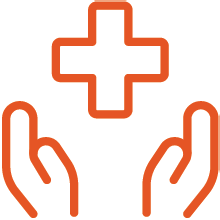C-reactive protein test
This simple blood test measures inflammation in the body. The results help diagnose infection and, sometimes, predict the risk of heart attack.
Overview
C-reactive protein, also called CRP, is a protein made by the liver. The level of CRP increases when there's inflammation in the body. A simple blood test can check your C-reactive protein level.
A high-sensitivity C-reactive protein test, also called hs-CRP test, is more sensitive than a standard C-reactive protein test. That means the high-sensitivity test can find smaller increases in C-reactive protein than a standard test can.
The hs-CRP test can help show the risk of getting coronary artery disease. In coronary artery disease, the blood vessels of the heart narrow. Narrowed blood vessels can lead to a heart attack.
Why it's done
A C-reactive protein test may be done to:
- Check for infection.
- Help diagnose a chronic inflammatory disease such as rheumatoid arthritis or lupus.
- Learn your risk of heart disease.
- Learn your risk of a second heart attack.
A note about C-reactive protein tests for heart disease
A high level of hs-CRP in the blood has been linked to an increased risk of heart attacks. Also, people who have had a heart attack are more likely to have another heart attack if they have a high hs-CRP level. But their risk goes down when their hs-CRP level is in the typical range.
An hs-CRP test isn't for everyone. The test doesn't show the cause of inflammation. So it's possible to have a high hs-CRP level that doesn't affect the heart.
An hs-CRP test may be most useful for people who have a 10% to 20% chance of having a heart attack within the next 10 years. This is known as intermediate risk. A healthcare professional can determine your risk using tests that look at your lifestyle choices, family history and overall health.
Risks
A C-reactive protein test or a high-sensitivity C-reactive protein test poses little risk. You might have soreness or bruising around the site where blood was drawn. Rarely, the site can become infected.
How you prepare
To prepare for a C-reactive protein test, your healthcare team might ask you not to do hard exercise, such as intense weight training or a long run, before the test. Such activities can cause a sudden jump in the C-reactive protein level.
Some medicines can affect the CRP level. Tell your healthcare professional about the medicines you take, including those you bought without a prescription.
If your blood sample will be used for other tests, you may be told not to eat or drink for a while before the test. For example, if you're having an hs-CRP test to check for heart disease, you also might have a cholesterol test at the same time.
Your healthcare professional tells you how to prepare for your test.
What you can expect
A C-reactive protein test requires a blood sample. To take a sample of your blood, a healthcare professional places a needle into a vein in your arm, usually at the bend of the elbow. The blood sample goes to a lab to be tested. You can return to your usual activities right away.
Results
It can take a few days to get C-reactive protein test results. Your healthcare professional can explain what the test results mean.
C-reactive protein is measured in milligrams per liter (mg/L). Results equal to or greater than 8 mg/L or 10 mg/L are considered high. Range values vary depending on the lab doing the test.
A high hs-CRP test result is a sign of inflammation. It may be due to serious infection, injury or chronic disease. Your healthcare professional may recommend other tests to determine the cause.
Results for an hs-CRP test are usually given as follows:
- Lower risk of heart disease: Less than 2.0 mg/L.
- Higher risk of heart disease: Equal to or greater than 2.0 mg/L.
A person's CRP levels vary over time. A coronary artery disease risk assessment usually is based on the average of two hs-CRP tests. It's best if the tests are taken two weeks apart. Values above 2.0 mg/L may mean an increased risk of heart attacks or risk of a repeat heart attack.
The hs-CRP level is only one risk factor for coronary artery disease. Having a high hs-CRP level doesn't always mean a higher risk of developing heart disease. Other test results can help determine the risk.
Talk to your healthcare professional about your risk factors for heart disease and ways to try to prevent it. Lifestyle changes or medicines might help lower the risk of a heart attack.
© 1998-2025 Mayo Foundation for Medical Education and Research (MFMER). All rights reserved.
Terms of Use





